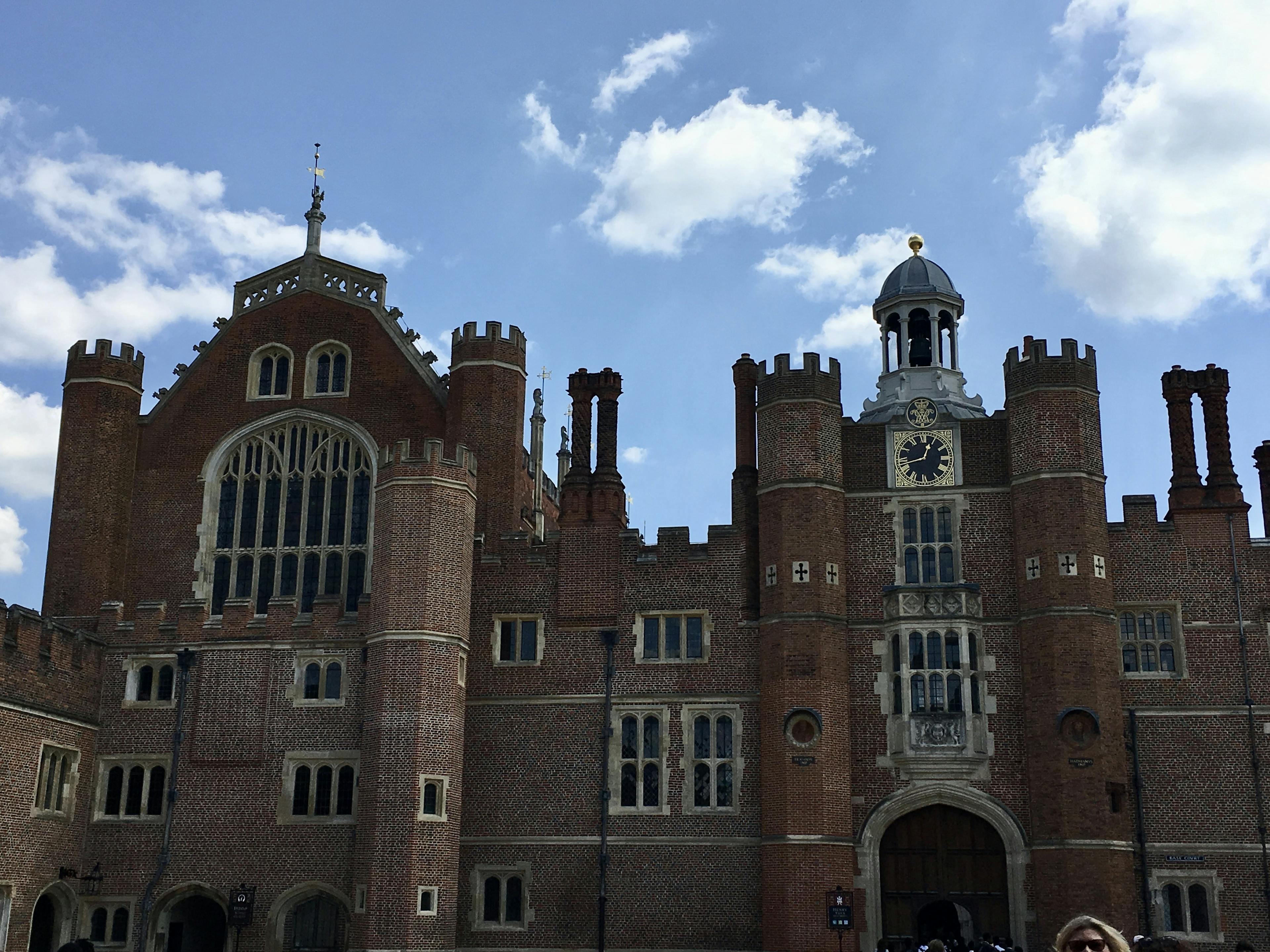Welcome
Continuing with our Palaces theme, we visit Hampton Court this week, built by Cardinal Thomas Wolsey.
Then in ‘Out and About, we travel to Oxford and Christ Church Cathedral & College.
We are very fortunate to only live 20 minutes south of Oxford, so always take visitors there when they come to stay with us.
As the weather gets cooler here and the days shorter, I am wishing my family and friends in the southern hemisphere a much warmer spring and summer than we had in England this year!
Till next week, enjoy Traveling Through History with me
Michelle
Savvy Travel Historian
September – Palaces:
Hampton Court Palace

Background
Built by Cardinal Thomas Wolsey, Henry VIII’s Chief Minister, in 1514, Hampton Court Palace is a stunning reminder of the lavishness of the Tudor Court during the 1600’s.
Located in East Molesey, the palace is around one hour by train (south-west) from London’s Waterloo Station.

History
Thomas Wolsey
When Wolsey took over the site in 1514, he set about creating the most lavish palace in England. Over the next seven years, he spent a fortune on it (200,000 Crowns).
Historians have said that they believed Wolsey was trying to recreate some of the grand cardinal palaces of Europe, to show Rome that even English cardinals can live lavishly.

There is no doubt he succeeded, and it herald the beginnings of Tudor craftsmanship from the plainer style seen during the early years of this period, to a much more renaissance style, inspired by a small group of Italian craftsman who lived in England during this time.
The Tudor section of the palace was completed in 1525 and Henry VIII stayed in the ‘state apartments’ that Wolsey had built for him, in that same year.

But Wolsey was not to enjoy his palace for long and in 1529, when he knew that noblemen of the Court were plotting against him to the King, he gave Henry Hampton Court as a ‘gift’. It was not enough to save him, and he died in 1530, whilst on his way back to London, after being arrested, to face trial for treason.
Henry VIII
Within six months of owning Hampton Court, Henry set about expanding it.
One of the first things that needed to be done was to increase the size of the kitchens to enable his massive court (over 1,000 were with him at all times) to be fed.
The Tudor kitchens are still in existence today.

Between 1532 and 1535, Henry added a Royal Tennis Court (which we now call Real Tennis), one of only twenty-five existing in the UK today. It is also the oldest extant (surviving) court in existence.

Additionally, he added the Great Hall, the largest room in the palace, where up to 600 members of the court dined with the King twice a day. The Flemish tapestries that line the hall, showing the Story of Abraham, were woven in 1540.

In 1603 the first performances of Shakespeare’s Hamlet and Macbeth for the newly crowned James I, were here.
It was also the meeting place for the 1604 ‘Hampton Court Conference’, which ultimately gave us the authorised version of the King James Bible in 1611.
The Great Watching Chamber was the room where courtiers and those wishing to speak to the king would gather, waiting to enter the private state apartments.

The Yeoman of the Guard were stationed in this room to control access to the monarch.
While much of the room was updated over the centuries (the fireplace for example is not Tudor), the ceiling is a wonder of Tudor craftsmanship.

Its intricate design weaves together the coat of arms and badges of Henry and his 3rd and favourite wife, Jane Seymour, as well as the Tudor rose, along with the Beaufort Portcullis, the coat of arms of his grandmother Margaret.
This room also has a stained-glass window that is considered one of the most important and magnificent in Britain.

The Haunted Gallery is called that due to the story of the ghost of Catherine Howard (Henry’s 5th wife) who was arrested at Hampton Court in 1540. She was under house arrest in her chambers, when she managed to break free of her guards and she ran down the gallery to towards the chapel to try to speak to the King. She was caught just before and screamed for the king to have mercy on her as she was dragged back to her rooms.
Her ghost is thought to still shriek along the gallery sometimes.

The Chapel Royal has been holding services for over 450 years. The Royal Family would sit upstairs looking down on worshipers (as shown in the image below).

Wolsey built the bulk of the chapel, but it was Henry who replaced the ceiling with this magnificent vaulted one (with gilded and carved pendants) in 1535-6. It is truly stunning.

The Georgian Rooms
William III built the King’s Apartments from 1689-1702 after instructing Sir Christopher Wren to upgrade the accommodation.
Originally, Wren intended to demolish Henry VIIIs additions, but available funds and time were short so only the south and east sides were rebuilt.

In 1986 the apartments were badly damaged by fire and took six years to restore.
The King’s Privy Chamber was decorated elaborately, in rich crimson for the throne and canopy, and it was in this room that the king received ambassadors and held court functions.

Palace Gardens

The 60 acres of gardens around the palace were originally used for agriculture but as time progressed and the palace was used more by royalty, they began to be used more for recreational pursuits.

While the Home Park was originally used as a deer park, the deer now roam in both the Home Park and Bushy Park, which is used for parking for visitors now. You walk past many of them on your way to the palace entrance if you go there by car.
The Home Park also includes a golf club established in the 19thC.

The Privy Garden
Little of the original Privy Garden established for Henry VIII survives, as William III had a parterre created in 1702.

During the Civil War, Charles I found himself under house arrest at the palace and even attempted to escape through the Privy Garden but was recaptured before his execution in 1649.
Henry VIIIs ‘pond gardens’ were created in 1535 and the walls surrounding them (from the same period) give us an idea of how the sunken gardens would have looked during this time. The ponds contained live fish, that were used by the kitchens to feed the court.

The lower orangery on the south side, was originally for Mary II’s collection of exotic plants but is now used to display the art works of Andrea Mantegna’s Triumphs of Caesar.

In 1768 Capability Brown planted the ‘Great Vine’. It is the oldest known grape vine in the World and still produces 500-700lbs (227-318kg) of grapes each year that is sold in the palace shops.

RHS Hampton Court Palace Flower Festival
For 30 years, the Royal Horticultural Society has been holding a flower festival at Hampton Court in the area of the gardens surrounded by the Long Water. It was created for Charles II in the 1660s.
Glimpses of the palace can be seen as you tour the displays and exhibitions. We were lucky enough to go this year and it was a great day out.

Relevant Travel Information:
All information needed to visit Hampton Court can be found here
https://www.hrp.org.uk/hampton-court-palace/#gs.59llhi
Tickets
https://www.hrp.org.uk/hampton-court-palace/visit/tickets-and-prices/#gs.59ljgr
Out & About
To keep with our theme of places built by Cardinal Wolsey, when our daughter Amy recently visited, I took her to Christ Church College & Cathedral.

In 1525, Wolsey suppressed the minor monastery of St Frideswide’s Priory on the site now occupied by the college.

Originally names Cardinal College, Wolsey planned it on a grand scale and was only three-quarters finished when he fell from grace in 1529.

Taken over by Henry VIII, it was re-founded as King Henry VIII’s College but in 1546 (after the break with the Rome Catholic Church) it was renamed again and re-founded, this time to Christ Church.
The college has 175 acres of land and includes Christ Church meadow, which is a much-used thoroughfare in Oxford, linking Iffley Road and St Aldates.

The cathedral has had a choir there since 1526 and it is one of the smallest cathedrals in the Church of England.

An interesting side note on the establishment of the then Cardinal College, was that funds from the dissolution of Wallingford Priory (Holy Trinity) were also used by Thomas Wolsey. Wallingford is the village we now live in, but nothing remains of the priory here, which was believed to be in the Bullcroft, which is now a nice park where we walk our dog, Chloe.
https://www.wallingfordtowncouncil.gov.uk/wallingfords-history-and-heritage/the-priory/
Relevant Travel Information:
Made even more popular to visit by the Harry Potter films, Christ Church tickets should be booked in advance, especially in the summer.
Tickets
You can purchase tickets here.
https://www.chch.ox.ac.uk/tickets
The Picture Gallery is also worth visiting and has an additional entrance fee:
https://www.chch.ox.ac.uk/picture-gallery/visiting-gallery
Thank you for reading Traveling Through History. This post is public so feel free to share it.

Michelle is a speaker, author, content marketer, historian and mother of 3 boys.
After 25 years in business and as the ‘Content Marketing Queen’ for the past 12 years, she has helped countless small businesses understand and develop their content strategies and focus on a customer first approach.
Savvy Travel Historian is her passion project, and her weekly newsletter is available on Substack, Paragraph and Mirror. The latter two allows you to collect each Issue as an NFT.
Michelle is co-host of the Web3 By Three Podcast, a weekly show which talks about current stories in the Web3 space and how it applies to B2B marketing, sales and operations. The show is recorded live every Wednesday at 4pm EST/ 9pm UTC on LinkedIn, YouTube & Bolt+.
You can follow Michelle in these places:
Savvy Travel Historian Instagram

